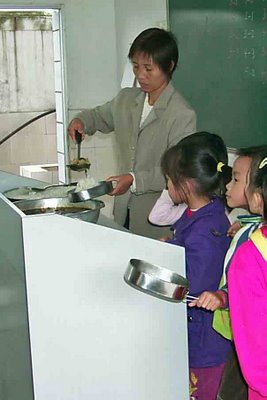Marvelous Beijing Opera Performance
Jingju, literally "drama of the capital" or the Beijing Opera as it is known in English, gave two performances in Chengdu on October 20-21. Charles, husband of the YMCA General Secretary, invited me to attend the second performance with him. It was a fantastic experience!! The Jingju performed The Story of Judge Bao & the Case of Qin Xianglian -- one of the all-time favorite plays of the Chinese. The opera is "about the legendary Judge Bao, a stern but fair dispenser of justice and upholder of the common man -- or in this case, common woman."
 "In it, the scholar Chen Shimei leaves his wife, Qin Xianglian, in the care of his parents and goes to the capital to take the national examinations. He places first and charms the Empress Dowager, who arranges for him to marry her daughter, the Emperor's younger sister -- to secure his position, Chen tells everyone that he has never been married before. While Chen is in the capital, his parents die in a widespread famine, and his original, commoner wife and children come to the capital in search of his protection.
"In it, the scholar Chen Shimei leaves his wife, Qin Xianglian, in the care of his parents and goes to the capital to take the national examinations. He places first and charms the Empress Dowager, who arranges for him to marry her daughter, the Emperor's younger sister -- to secure his position, Chen tells everyone that he has never been married before. While Chen is in the capital, his parents die in a widespread famine, and his original, commoner wife and children come to the capital in search of his protection.
Although Qin tries her best to win his recognition, Chen refuses to acknowledge them and orders a palace guard to kill them. The assassin, however, is moved by Qin Xianglian's story, lets them go, and then kills himself rather than complete his mission. With the assistance of a kindly innkeeper and a sympathetic government minister, Qin then goes to Judge Bao and accuses Chen of attempting to murder her and his original heir and of causing Han Qi's death.
With the assistance of a kindly innkeeper and a sympathetic government minister, Qin then goes to Judge Bao and accuses Chen of attempting to murder her and his original heir and of causing Han Qi's death.
 In the end, however, Judge Bao holds firm--and Chen is beheaded."
In the end, however, Judge Bao holds firm--and Chen is beheaded."

The poster and story are taken from "A Guide to Jingju" published by the Department of Theatre and Dance, College of Arts and Humanities, University of Hawaii at Manoa for the Kennedy Theatre 2001-2002 season. For more on the Beijing Opera, see the Chinese Opera Links Page.





 The highest in western China, fourth highest in the nation and seventh highest in the world, the tower will send out TV signals to a radius of 80 kilometers, reaching 18 million people. It is hoped that the tower will serve as a symbol of Chengdu and its tourism.
The highest in western China, fourth highest in the nation and seventh highest in the world, the tower will send out TV signals to a radius of 80 kilometers, reaching 18 million people. It is hoped that the tower will serve as a symbol of Chengdu and its tourism. A big restaurant up 213 meters will attract visitors who want to get a bird's eye view of the city. Other entertainment facilities being constructed include a modern cinema. The exact opening date of the tower has not be determined.
A big restaurant up 213 meters will attract visitors who want to get a bird's eye view of the city. Other entertainment facilities being constructed include a modern cinema. The exact opening date of the tower has not be determined.





 If you walk Chunxi Lu before 9:00 AM, it is not unusual to see one or more staff teams from the stores along the pedestrian road holding their morning pep rally before starting work.
If you walk Chunxi Lu before 9:00 AM, it is not unusual to see one or more staff teams from the stores along the pedestrian road holding their morning pep rally before starting work.





















